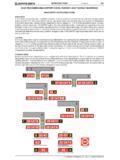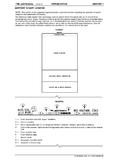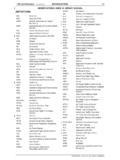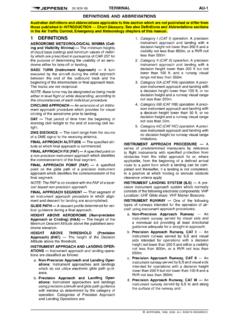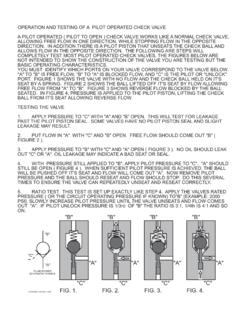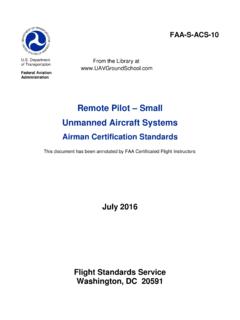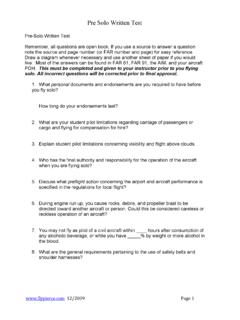Transcription of Private Pilot Airman Knowledge Test Guide — …
1 Private Pilot Airman Knowledge Test Guide 10001387 -022 March 17, 2017 Page 1 of 10 Private Pilot Airman Knowledge Test Guide 10001387 -022 Corrections, March 2017 With the rollout of the Private Pilot Airman Certification Standards (ACS) in 2016, the FAA made a number of changes to their Knowledge test, immediately removing many questions that are considered obsolete or irrelevant. They have also published a new computerized testing supplement that contains all redrawn figures. A number of errors were introduced into the Private Pilot Test Guide when some of these figures were redrawn in the supplement FAA-CT-8080-2F. Some were drawn improperly and subsequently corrected in FAA-CT-8080-2G. Other figures, such as sectional charts, contained changes that invalidated some of the questions. Examples include: Changes in magnetic variation. This resulted in changes of 2 to 5 degrees in questions requiring calculation of a magnetic course, magnetic heading, or compass heading.
2 In one figure, a VOR was relocated onto the field at Savannah Hilton Head International Airport. This resulted in noticeable changes in the results of any problem referencing the Savannah (SAV) VOR. One figure showing VOR indicators was redrawn in a way that made it apparent that the OBS settings were reciprocal of those in the previous version of the figure, which was not clearly drawn. This resulted in changes to the correct answer of all questions referencing this figure. Because the FAA does not publish changes to the affected test questions, Jeppesen editors are working to revise the test questions in the test Guide so that they work with the new figures. Keep in mind that questions published by Jeppesen and other test prep providers are sample questions designed to increase understanding of the learning objectives published in the Private Pilot Airman Certification Standards (ACS).
3 You should not expect to see these exact questions on your Private Pilot Airman Knowledge test. Jeppesen thanks the students and flight instructors that have helped us identify the affected questions. This report corrects the known issues in the Private Pilot Knowledge Test Guide . Changes are marked in blue. Question(s) Explanation En Route Flight Advisory Service (EFAS) The FAA Knowledge test no longer includes questions about En Route Flight Advisory Service (EFAS). Skip these questions. To obtain weather information during flight use the nearest FSS frequency. Radar summary charts The FAA Knowledge test no longer includes questions about radar summary charts. Skip these questions, and for actual flight planning, use digital radar information from or TWEB The FAA Knowledge test no longer includes questions about TWEB. You can skip these questions if desired.
4 Alaska pilots might still wish to review this information. Questions about FAA flight plan forms The FAA is adopting the ICAO flight plan form, and the Knowledge test no longer includes questions that use the old FAA flight plan form. Skip these questions. The FAA intends to create questions that reference the new flight plan form in the near future. Private Pilot Airman Knowledge Test Guide 10001387 -022 March 17, 2017 Page 2 of 10 Questions that require the use of a plotter to measure distance on a chart The FAA is currently omitting these types of questions from the test because the FAA figures in the most-recent supplement are not properly scaled to enable accurate measurements with a plotter. If desired, you can still solve these problems by marking the distances from the scale at the edge of the sectional chart excerpt on the edge of a piece of paper and then using that paper to measure distance.
5 Questions that involve multiple interpolations across multiple charts The FAA Knowledge test no longer includes questions that involve multiple interpolations across multiple charts. Skip these questions, and in actual flight planning, always use the more conservative values. Airport/Facility Directory Change all references Airport/Facility Directory references to Chart Supplement. Tri-color VASI The FAA Knowledge test no longer includes questions about tri-color VASI. Skip these questions. 2-71 2-72 These two questions should reference figure 7, not figure 6.) ADF/NDB The FAA Knowledge test no longer includes questions ADF or NDB. You can skip these questions, although this Knowledge could be useful if you operate an airplane with an ADF or any kind of bearing pointer. 2-86 PLT041 High and low were reversed on this question, making it the same as 2-85.
6 It should read as follows: If a flight is made from an area of high pressure into an area of low pressure without the altimeter setting being adjusted, the altimeter will indicate A lower than the actual altitude above sea level. B higher than the actual altitude above sea level. C the actual altitude above sea level. 2-86. Answer B. GFDPP 2-59, AW Remember, from high to low, look out below. In other words, the aircraft will be at a lower true (actual) altitude than indicated, so the altimeter indicates higher than actual. Private Pilot Airman Knowledge Test Guide 10001387 -022 March 17, 2017 Page 3 of 10 3-27 PLT309 The previous correct answer, as published by the FAA, was not very close. We revised answer C to make it closer to what you would compute using the load factor value from the table. (Refer to figure 2.) If an airplane weighs 3,300 pounds, what approximate weight would the airplane structure be required to support during a 30 banked turn while maintaining altitude?
7 A 1,200 pounds B 3,100 pounds C 3,800 pounds 3-27. Answer C. GFDPP 3-60, PHB The load factor for 30 degrees of bank is [(1 Cos (30 )]. The airplane weight (3,300 lb) multiplied by the load factor ( ) is 3,810 pounds, which the wing structure must support. 3-28 PLT309 The previous correct answer, as published by the FAA, was not very close. We revised answer B to make it closer to what you would compute using the load factor value from the table. (Refer to figure 2.) If an airplane weighs 4,500 pounds, what approximate weight would the airplane structure be required to support during a 45 banked turn while maintaining altitude? A 4,500 pounds B 6,400 pounds C 7,200 pounds 3-28. Answer B. GFDPP 3C, PHB At 45 degrees of bank, the load factor is The wing loading would be 4,500 lb , or 6,365 lb. 4-47 PLT077 Figure 49 was changed to an airport chart for an actual airport, requiring changes to the question.)
8 (Refer to figure 49.) According to the airport diagram, which statement is true? A Takeoffs may be started at position D on Runway 32, but the landing portion of this runway begins at position E. B Takeoffs may be started at position A on Runway 25, and the landing portion of this runway begins at position B. C The takeoff and landing portion of Runway 25 begins at position B. 4-47. Answer B. GFDPP 4-24, AIM At many airports, the area prior to a displaced threshold may be used for taxi and takeoff (and rollout after landing). Landings may be made after the displaced threshold at position B on Runway 25. 4-68 PLT141 What is the purpose of the runway/runway hold position sign? A Denotes entrance to runway from a taxiway. B Denotes area protected for an aircraft approaching or departing a runway. C Denotes intersecting runways. 4-68. Answer C.
9 GFDPP Chap 4B, AIM These signs are installed together with pavement markings only on runways that are used for land-and-hold-short operations (LAHSO) or taxiing operations. Like other holding position signs, they consist of white runway numbers on a red background. Private Pilot Airman Knowledge Test Guide 10001387 -022 March 17, 2017 Page 4 of 10 4-80 PLT064 (Refer to figure 27.) (Area 5) What is the CTAF/UNICOM frequency at Barnes County Airport? A MHz. B MHz. C 1402 kHz. 4-80. Answer B. GFDPP 4-47, AIM The CTAF symbol is next to the UNICOM frequency is the ASOS weather frequency and 1402 is the field elevation. NOTE: Answer C, although incorrect, previously referenced an AM broadcast station that is no longer charted. 4-86 PLT064 (Refer to figure 21, area 1.) The NALF Fentress (NFE) Airport is in what type of airspace?
10 A Class C. B Class D. C Class E. 4-86. Answer B. GFDPP 4C, Chart Legend NFE is outside the solid magenta lines delineating the Norfolk Class C airspace, but inside a dashed blue circle indicating Class D airspace. 4-139 PLT064 (Refer to figure 22, Area 3.) What type military flight operations should a Pilot expect along IR 644? A VFR training flights above 1,500 feet AGL at speeds less than 250 knots. B IFR training flights above 1,500 feet AGL at speeds in excess of 250 knots. C Instrument training flights below 1,500 feet AGL at speeds in excess of 150 knots. [Question removed] The IR644 label on the military training route is not visible in the latest figure 22. 4-143 PLT040 (Refer to figure 27, Area 5.) The airspace overlying and within 5 miles of Barnes County Airport is A Class D airspace from the surface to the floor of the overlying Class E airspace.


